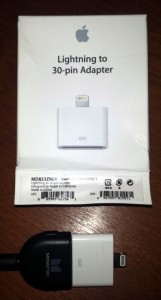 On the way home from the Building Business Capability (BBC) conference last week, my wife Elizabeth and I stopped in at an electronics store in Las Vegas. We wanted to listen to an audio book on her new iPod, and the gizmo we have to play the iPod in the car has the traditional iPod connector used for many years.
On the way home from the Building Business Capability (BBC) conference last week, my wife Elizabeth and I stopped in at an electronics store in Las Vegas. We wanted to listen to an audio book on her new iPod, and the gizmo we have to play the iPod in the car has the traditional iPod connector used for many years.
Unfortunately our new iPod has the smaller connector and the transmitter would not let us hear our audio book on the long drive home. Well, we just needed to buy a new gizmo, right? That’s when we got the bright idea to buy one on the way home and we found a store near the conference hotel.
I went into the store and told our sales associate I needed a new wireless car transmitter that would work with the new iPod. The plug name I used was the “Thunderbolt” or something, not remembering the actual name. (Knowing me, I probably complained about Apple as I was doing so, but that was just letting off some steam.) As we walked to the iPod accessories, the clerk asked me a few questions, and without even seeing the components, she arrived at the most important question: “Are you just trying to plug your iPod into the old adapter?” After thinking a moment about it, I quickly said “Yes, that’s it!”
 So, we quickly left the expensive transmitter section and went to the less-expensive adapter aisle, where she pointed to a “Lightning to 30-pin Adapter.” This little component was exactly what I needed, since it let us keep what we had, and for half the cost the new iPod worked perfectly with the old wireless transmitter. They had one in stock and I was on my way (except the wait to check out was three times as long as the decision process, but that’s the way with implementations, isn’t it?)
So, we quickly left the expensive transmitter section and went to the less-expensive adapter aisle, where she pointed to a “Lightning to 30-pin Adapter.” This little component was exactly what I needed, since it let us keep what we had, and for half the cost the new iPod worked perfectly with the old wireless transmitter. They had one in stock and I was on my way (except the wait to check out was three times as long as the decision process, but that’s the way with implementations, isn’t it?)
The clerk could have sold me a more expensive new transmitter, but the adapter was all I really needed. Plus, we can use it with any device that accepts the old 30-pin connector. Actually, until that day I had no idea that a) the name of the new plug was a “lightning” and b) my old connector had 30 pins and even had a name! There is no way I could have walked into that store to ask for precisely what I needed when I didn’t know what it was I actually did need.
The clerk was an excellent business analyst/consultant in that she asked good questions and didn’t let me “jump to a solution.” Even though I told her what I wanted she skillfully advised me by asking need-related questions and we arrived at a better and cheaper solution than the one I came in with.
This transaction is a great microcosm of what we project professionals can do for our stakeholders and business partners. When faced with a solution request, we need to:
- Ask probing questions to get at the true business need.
- Guide our customers to solutions that deliver the value they want and not just what they ask for. If we simply provide the requested solution we are just highly-paid order takers. Many times those requested solutions will be things the requester is familiar with (like the transmitter) and they will not even know about viable alternatives (like the adapter).
- Recommend the solution and let the business decide. Using my iPod analogy, if I had insisted on a new transmitter the clerk would not have told me “No, you should not buy the expensive item – you only need an adapter.” What we should do is analyze the situation, make our recommendation, and explain the rationale. The stakeholder with the budget gets to make the final decision.
To summarize, the story about the adapter is one variation of a business case. Given a situation, we analyze the need, and make a recommendation. The “buyer” makes the decision and we can help implement and evaluate that decision. (Speaking of evaluating, the adapter worked great and we enjoyed our book on the ride home from BBC.) The overall framework for a solid business case is represented by the acronym SARIE. For more on this subject and an explanation of SARIE, see my series of articles (mentioned below).
==========================
Follow-up this post to learn more:
 Read my series on business cases, originally published for a PMI Global Congress. Search for “Creating Bulletproof Business Cases.”
Read my series on business cases, originally published for a PMI Global Congress. Search for “Creating Bulletproof Business Cases.”- Read about business cases; one of my favorite books on the subject is:
Making Technology Investments Profitable: ROI Road Map from Business Case to Value Realization. (c) 2011 by Jack M. Keen - Look into attending our Bulletproof Business Case course.
Richard Larson, PMP, CBAP, PMI-PBA, was the founder of and is now a consultant for Watermark Learning. He is a successful entrepreneur with over 35 years of experience in product development, business analysis, project management, training, and consulting. As an internal entrepreneur, Rich led the development of several Watermark Learning online products as a business analyst and product owner.
Rich is a frequent speaker at Business Analysis and Project Management national conferences and IIBA® and PMI® chapters around the world. He has contributed as a lead author to the BA Body of Knowledge version 2.0 and 3.0 and was a lead author on PMI’s Business Analysis Practice Guide. He and his wife Elizabeth Larson have co-authored five books on business analysis.


 New Horizons
New Horizons
 Project Management Academy
Project Management Academy
 Six Sigma Online
Six Sigma Online
 Velopi
Velopi
 Watermark Learning
Watermark Learning
 Login
Login




 New Horizons
New Horizons
 Project Management Academy
Project Management Academy
 Velopi
Velopi
 Six Sigma Online
Six Sigma Online
 Watermark Learning
Watermark Learning